December 28 - 29, 2002
on how we saw cacti and missiles, immigrated in the middle of United States, almost slept under a bridge -- and finally reached real White Sands
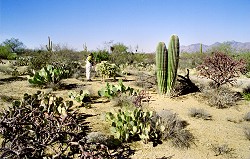 |
||
| Saguaro NP I did not know which one of these fascinating cacti I should photograph first... |
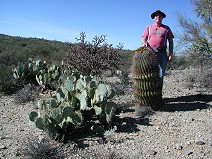 |
||
| A barrel cactus Similarity (barrelness) is by chance only. |
Tucson morning caught us in a worn-out state of minds. Two days behind the wheel began to show. We longed to visit a historic downtown, but let a sign "Old Tucson" fool us. After driving through switchbacks among giant cacti, we consulted our map that revealed us: non-existence of an old (certainly attractive) settlement was not caused by my navigational ineptness, but by a fact that the arrow at a freeway pointed to Old Tucson, yet leaving out that it was Old Tucson Studios, built in 1939 for the movie Arizona. We did not want to see museums and studios, especially now that daylight finally presented us with southern Arizona landscape, which we had missed on the day before thanks to an early sunset. Since Saguaro National Part is right next to Tucson, our choice was clear.
For some reason, I always imagined saguaro, the symbolic cactus of Arizona, a lot smaller.
That's why I was surprised by on average thirty feet tall hunks. Accessible part of the park
is rather tiny. It sports a one way loop, only sometimes allowing on or two cars parking
on the shoulder; hence we presented more an exception than a rule -- others were simply taking pictures
out of their vehicles -- while we stepped out occasionally and walked undisturbed among the cacti,
spotting nests that various birds had dug in saguaros.
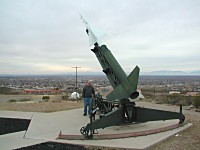 |
||
| Nike Ajax and Sid white stripe in front of mountains, right of the missile, is White Sands, IMAX building peeks out behind Sid. |
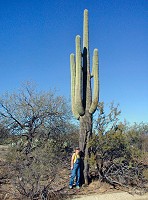 |
||
| Saguaro nicely contrasts with Péťa, tiniest member of our expedition. |
Noon approached and we haven't moved much away from Tucson, and had almost three hundred and fifty miles to Alamogordo, our evening destination. Even though we spent the whole afternoon driving, we only got to Las Cruces by dinnertime, defaulting into a Mexican cantina. This close to our southern border, we could not really count on any more interesting cuisine. Nothing against Mexican food, but I find it rather monotonous. Whatever you order, it tastes more or less the same.
During last seventy miles to Alamogordo I napped. Unfortunately this stretch of the highway, some road work was in progress, and traffic was detoured here and returned to regular route there, impeded by crawling low speed limits, interrupted by improvised traffic lights. When it finally got better and it seemed we would reach our lodging before midnight, Sid started breaking abruptly. Immigration Services had built a checkpoint in the middle of a desert in the middle of a military base and demanded to know who we were. We admitted having two green cards (Sid and I) and one tourist (Petra); they let us pass.
Which, however, did not end our journey. At Alamogordo we headed for Motel 6 that turned out to be full. An attentive receptionist called all places in the town, from Bombay Stars to luxurious apartments -- and did not find a single room. We had no other option but to embark back across those seventy miles, through the road construction section to Las Cruces. I shall spare you details of the rest of the night -- after many miles and many hotels we ended in one motel that only had smokers' rooms.
Hence, our expedition strongly resembled patients of a sanatorium for lung diseases in the morning.
Coughing and ruckling, we drove (again) through the highway detour and got stopped by Immigrations.
This time, they did not get placated by our simple declaration and demanded to check our documents thoroughly.
What can I say: I am pleased by the official alertness on one side, but on the other side I don't get why
a) they check us in the middle of New Mexico (quite some distance from the nearest border), and b)
why everybody who SAYS that he/she is a U.S. citizen, is waved through without any verification whatsoever.
It's obviously a rule: a honest dummy gets harassed, an arrogant crook has nothing to fear.
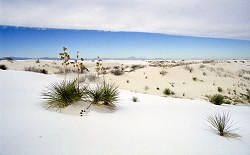 |
||
| White Christmas came to White Sands, New Mexico snow (down) is whitest, second is the band of clouds (up), gypsum sands are only third whitest. Yucca tops peek out from dune crests. |
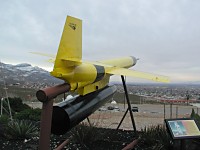 |
||
| X-7A this missile flew more than forty years ago. It reached then a speed record of 2881 mph. |
Having returned back all the way to Alamogordo, we played it safe and reserved our rooms for the night, and only then went to check out the local IMAX. This panoramic movie theater is a part of a Space Museum. We bought ticket for an evening show about a rainforest, and walked among outdoors expositions of various missiles and their parts. A missile test range lays just outside of Alamogordo and many historical test were done there, so the museum can offer local history specialities that made world history: rusted parts of German V-2 of WW2 (teams of engineers and scientist who designed these weapons came to the USA at the end of the war, and continued to work here at bases in Texas and Alabama), all the way to engines of Saturn V first and second stages. We passed on the indoor part of the museum, leaving it for later, as we wanted to take advantage of remaining daylight and see White Sands.
Right at the entrance they told us that half of the (drivable) part of the park was closed due to snow.
That was our first disappointment. Our second one became apparent when we stepped out of our car. Because
of the snow, the sands did not seem white at all. They were wet (and thus yellowish), and contrasting too
much with the (really white) snow. To complete the mess, this rather rare condition had inspired many local
families with children, and so these snow-covered dunes rung with laughter and squeals, while many sliding
and sledging devices were being used - those sold for the purpose as well as frisbees and plastic bags.
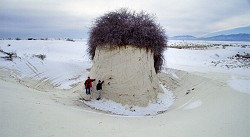 |
||
| At a head of a giant dug in the sand, left to right: Péťa, Carol. |
We turned our backs to noisy families and plowed out into the desert. This one is like I always imagined it -- dunes, sometimes a palm tree. Well, unless you notice that this sand is not really sand at all, it's gypsum. Dunes held very solid under the melting snow, I almost felt like atop snow banks. Dry gypsum (which we saw only on a video at a visitor center) behaves like regular sand, and similar to sandy deserts, winds form dunes and move them around all the time. Only a few species of plants manage to adapt to life under such harsh conditions. Yuccas root in the ground under the moving sands and actually welcome being covered by it. They grow fast and keep sticking the top out of a dune - it looks like a bunch of grass; one has some difficulty imagining that down under are several feet of a solid trunk. Unfortunately for the yucca, it requires the support of the sand hill, and once wind blows it away, trunks collapse and the plants die.
One species of bush uses another technique -- they root in the sand and quickly develop a dense system of root, reinforcing the gypsum into a very solid mass. After a dune moves on, the result looks like a giant head sticking out from the sands, with a ragged topknot of a bush on top.
Having vented out our smokey lungs, having satiated our photographic desires,
time came to experience some civilized culture. Péťa liked IMAX - it was her first encounter
with this huge projector (screen is really a dome so it's very suggestive and pulls you right
into the show), but the show itself was our third disappointment. I had expected aerial
shots, which would really utilize advantages of this panoramic technology; instead, I was
watching a frog's perspective view of a harvested trunk dragged through mud by a caterpillar
tractor (5 minutes), dreary job of a rainforest logger cutting a huge tree (10 minutes),
and had to endure listening to a predictable wailing of an ideologue plagued by a speech
impediment (he lisped). The so-called scientists, who briefly interrupted the monotonous
eco-terrorist indoctrination by few sentences, delivered their expert statements, e.g.
"I had never expected to see rainforest this close. We really don't know much about it
and we collect samples. I wish my mother could see me here..."
I understand that rainforest logging is a controversial topic, but after twenty minutes
I was bored to tears. In the end, we never learned anything about the actual forest --
no information on flora, fauna, ecology... it was all a boring lecture on how destructive
humanity is.
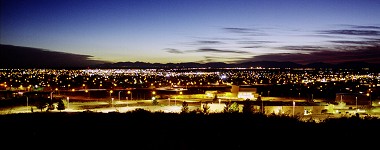 |
||
| Alamogordo, New Mexico. |
There was still a wonderful evening ahead of us -- it was only seven o'clock and we were free to relax in our warm, cozy, clean room, and talk, eat ice cream -- one of the few days we did not spend driving until exhaustion, looking for accommodation. I think that it was exactly what we needed now.
| Copyright © 2003-2005 by Carol & Sid Paral. All rights reserved. |